Effect of Landscape Elements on Public Psychology in Urban Park Waterfront Green Space: A Quantitative Study by Semantic Segmentation
Abstract
1. Introduction
- (1)
- Analyze the differences between different semantic segmentation models and datasets applied to urban park waterfront green space images, and find out which semantic segmentation model and dataset are capable of efficiently and accurately obtaining quantitative data on urban park waterfront green spaces;
- (2)
- Using semantic segmentation and virtual reality as technical support, analyze what impact urban park waterfront green spaces have on the public psyche;
- (3)
- To further explore whether different landscape elements in urban park waterfront green spaces have an impact on public psychology, and what the specific mechanisms of impact are.
2. Materials and Methods
2.1. Study Sites
2.2. Virtual Reality Image Acquisition
2.3. Participants and Procedure
2.4. GSA-Based Landscape Element Screening
| Type | Landscape Indicators | Calculation Method | Quantification Methods | No. |
|---|---|---|---|---|
| Spatial elements | Sky openness | Proportion of the sky in the view | Semantic segmentation | K1 |
| Visual complexity | Space composition complexity index | Matlab | K2 | |
| Colorfulness of space | Colorful index of space elements | K3 | ||
| Natural elements | Green viewing ratio | Proportion of vegetation in the view | Semantic segmentation | Z1 |
| Blue viewing ratio | Proportion of water in the view | Z2 | ||
| Plant layers | Number of tree, shrub, and herb strata in the plant landscape | Counting statistics | Z3 | |
| Plant colorfulness | Number of colored foliage and flowering plant species | Z4 | ||
| Soil exposure | Proportion of bare soil in the view | Semantic segmentation | Z5 | |
| Plant growth condition | Condition of decaying and dead plants in the plant landscape, with = 0, without = 1 | Assignment statistics | Z6 | |
| Building elements | Building proportion | Proportion of buildings in the view | Semantic segmentation | J1 |
| Pavement proportion | The proportion of paving in the view | J2 | ||
| Pavement form | Masonry = 0, wood = 1, pebbles = 2 | Assignment statistics | J3 | |
| Vignette proportion | Proportion of vignettes in the view | Semantic segmentation | J4 | |
| Humanistic atmosphere | Proportion of traditional buildings in the view | J5 | ||
| Facility elements | Commercial facilities | The proportion of commercial facilities, such as cruise ships and amusement facilities | S1 |
2.5. Scene Quantization Decomposition Based on Semantic Segmentation
2.5.1. Model Selection and Semantic Segmentation Accuracy Improvement
2.5.2. Semantic Segmentation Accuracy Calculation
2.6. Statistical Analysis
3. Results
3.1. Results of Semantic Segmentation
3.2. The Public Psychological Response of Urban Park Waterfront Green Space
3.2.1. Test on Reliability and Validity
3.2.2. Public Psychological Response Results
3.3. How Do Landscape Elements Affect Public Psychology
3.3.1. Psychological Response Model Construction
3.3.2. Specific Mechanisms of Influence of Landscape Elements on Public Psychology
4. Discussion
4.1. Semantic Segmentation Model and Dataset for Urban Park Waterfront Green Space
4.2. The Impact of Virtual Reality-Based Urban Park Waterfront Green Space on Public Psychological Response
4.3. Mechanisms of Influence of Urban Park Waterfront Green Space Landscape Elements on Different Psychological Dimensions of the Public
4.3.1. Spatial Element
4.3.2. Facility Element
4.3.3. Natural Element
4.3.4. Construction Element
5. Limitations
6. Conclusions
- (1)
- In terms of the application of semantic segmentation, the results indicate that PSPNet is a more suitable semantic segmentation model for urban park waterfronts. In terms of dataset, compared to the model trained by the ADE20k dataset, the PSPNet trained by the dataset in this paper shows a higher level of accuracy, which can be used as a technical support to obtain quantitative environmental data of urban park waterfront green space efficiently and accurately;
- (2)
- In terms of the results of the public’s psychological response to urban park waterfront green spaces, urban park waterfront green spaces provide a psychologically healing environment for the public, with the psychological dimension > emotional dimension > cognitive dimension > behavioral dimension in the different psychological response dimensions. The public’s psychological relief is better in urban park waterfronts, while the effects of the behavioral dimensions, such as frequency of visits and length of stay, need to be improved;
- (3)
- In terms of the specific role played by landscape elements in urban park waterfront green spaces, among the four types of landscape elements, the spatial element is the element type with the greatest contribution to public psychology, followed by the facility element and the natural element, with the construction element producing the lowest impact. Specifically, rich spatial color, complex plant community forms, and good plant growth can provide positive effects on public psychology, while complex spatial composition, a higher proportion of construction, and facility elements can reduce people’s psychological mitigation effects.
Author Contributions
Funding
Data Availability Statement
Conflicts of Interest
References
- Liu, Q.; Xu, C.; Ji, G.; Liu, H.; Shao, W.; Zhang, C.; Gu, A.; Zhao, P. Effect of exposure to ambient PM2.5 pollution on the risk of respiratory tract diseases: A meta-analysis of cohort studies. J. Biomed. Res. 2017, 31, 130–142. [Google Scholar]
- Mustafić, H.; Jabre, P.; Caussin, C.; Murad, M.H.; Escolano, S.; Tafflet, M.; Périer, M.C.; Marijon, E.; Vernerey, D.; Empana, J.P. Main air pollutants and myocardial infarction: A systematic review and meta-analysis. Jama J. Am. Med. Assoc. 2012, 307, 713–721. [Google Scholar] [CrossRef]
- Kramer, C.K.; Leitão, C.B.; Viana, L.V. The impact of urbanisation on the cardiometabolic health of Indigenous Brazilian peoples: A systematic review and meta-analysis, and data from the Brazilian Health registry. Lancet 2022, 400, 2074. [Google Scholar] [CrossRef]
- Danielsson, M.; Heimerson, I.; Lundberg, U.; Perski, A.; Stefansson, C.G.; Akerstedt, T. Psychosocial stress and health problems: Health in Sweden: The National Public Health Report 2012. Chapter 6. Scand. J. Public Health 2012, 40, 121–134. [Google Scholar] [CrossRef] [PubMed]
- Liang, Z.; Wang, W.; Wang, Y.; Ma, L.; Liang, C.; Li, P.; Yang, C.; Wei, F.; Li, S.; Zhang, L. Urbanization, ambient air pollution, and prevalence of chronic kidney disease: A nationwide cross-sectional study. Environ. Int. 2021, 156, 106752. [Google Scholar] [CrossRef] [PubMed]
- Kristina, S.; Gölin, F.; Jan, S. Urbanisation and incidence of psychosis and depression. Br. J. Psychiatry 2004, 184, 293–298. [Google Scholar]
- Peng, G.; Song, L.; Elizabeth, J.C.; Qingwu, J.; Jianyong, W.; Lei, W.; Justin, V.R. Urbanisation and health in China. Lancet 2012, 379, 843–852. [Google Scholar]
- Okulicz-Kozaryn, A.; Valente, R.R. Urban unhappiness is common. Cities 2021, 118, 103368. [Google Scholar] [CrossRef]
- Tang, F.; Liang, J.; Zhang, H.; Kelifa, M.M.; He, Q.; Wang, P. COVID-19 related depression and anxiety among quarantined respondents. Psychol. Health 2020, 36, 164–178. [Google Scholar] [CrossRef]
- Zabini, F.; Albanese, L.; Becheri, F.R.; Gavazzi, G.; Giganti, F.; Giovanelli, F.; Gronchi, G.; Guazzini, A.; Laurino, M.; Li, Q.; et al. Comparative Study of the Restorative Effects of Forest and Urban Videos during COVID-19 Lockdown: Intrinsic and Benchmark Values. Int. J. Environ. Res. Public Health 2020, 17, 8011. [Google Scholar] [CrossRef]
- Pfefferbaum, B.; North, C.S. Mental Health and the COVID-19 Pandemic. N. Engl. J. Med. 2020, 383, 510–512. [Google Scholar] [CrossRef]
- Wilson, E.; Massachusetts, U. Biophilia; Harvard University Press: Cambridge, MA, USA, 1984; pp. 1–157. [Google Scholar]
- Guo, X.; Liu, J.; Albert, C.; Hong, X. Audio-visual interaction and visitor characteristics affect perceived soundscape restorativeness: Case study in five parks in China. Urban For. Urban Green. 2022, 77, 127738. [Google Scholar] [CrossRef]
- Hong, X.; Wang, G.; Liu, J.; Song, L.; Wu, E.T.Y. Modeling the impact of soundscape drivers on perceived birdsongs in urban forests. J. Clean. Prod. 2021, 292, 125315. [Google Scholar] [CrossRef]
- Mathew, W.; Amanda, S.; Kelly, H.; Sabine, P.; Deborah, S.; Michael, D. Blue space: The importance of water for preference, affect, and restorativeness ratings of natural and built scenes. J. Environ. Psychol. 2010, 30, 482–493. [Google Scholar]
- Jesper, J.A.; Stefan, W.; Mats, E.N. Stress Recovery during Exposure to Nature Sound and Environmental Noise. Int. J. Environ. Res. Public Health 2010, 7, 1036–1046. [Google Scholar]
- Volker, S.; Kistemann, T. Developing the urban blue: Comparative health responses to blue and green urban open spaces in Germany. Health Place 2015, 35, 196–205. [Google Scholar] [CrossRef]
- Garrett, J.K.; White, M.P.; Huang, J.; Ng, S.; Hui, Z.; Leung, C.; Tse, L.A.; Fung, F.; Elliott, L.R.; Depledge, M.H.; et al. Urban blue space and health and wellbeing in Hong Kong: Results from a survey of older adults. Health Place 2019, 55, 100–110. [Google Scholar] [CrossRef]
- Volker, S.; Kistemann, T. The impact of blue space on human health and well-being—Salutogenetic health effects of inland surface waters: A review. Int. J. Hyg. Environ. Health 2011, 214, 449–460. [Google Scholar] [CrossRef]
- Hooyberg, A.; Roose, H.; Grellier, J.; Elliott, L.R.; Lonneville, B.; White, M.P.; Michels, N.; De Henauw, S.; Vandegehuchte, M.; Everaert, G. General health and residential proximity to the coast in Belgium: Results from a cross-sectional health survey. Environ. Res. 2020, 184, 109225. [Google Scholar] [CrossRef]
- Garrett, J.K.; Clitherow, T.J.; White, M.P.; Wheeler, B.W.; Fleming, L.E. Coastal proximity and mental health among urban adults in England: The moderating effect of household income. Health Place 2019, 59, 102200. [Google Scholar] [CrossRef]
- Nieuwenhuijsen, M.J.; Kruize, H.; Gidlow, C.; Andrusaityte, S.; Antó, J.M.; Basagaña, X.; Cirach, M.; Dadvand, P.; Danileviciute, A.; Donaire-Gonzalez, D.; et al. Positive health effects of the natural outdoor environment in typical populations in different regions in Europe (PHENOTYPE) a study programme protocol. BMJ Open 2014, 4, e4951. [Google Scholar] [CrossRef]
- Mireia, G.; Wilma, Z.; Cristina, V.; Mathew, P.W.; Mark, J.N. Outdoor blue spaces, human health and well-being: A systematic review of quantitative studies. Int. J. Hyg. Environ. Health 2017, 220, 1207–1221. [Google Scholar]
- Tytti, P.P.; Mathew, P.W.; Benedict, W.W.; Joanne, K.G.; Lewis, R.E. Neighbourhood blue space, health and wellbeing: The mediating role of different types of physical activity. Environ. Int. 2019, 131, 105016. [Google Scholar]
- Katherine, J.A.; Sabine, P.; Paul, W.; Mathew, P.W. The beach as a setting for families’ health promotion: A qualitative study with parents and children living in coastal regions in Southwest England. Health Place 2013, 23, 138–147. [Google Scholar]
- Gao, Y.; Zhang, T.; Zhang, W.; Meng, H.; Zhang, Z. Research on visual behavior characteristics and cognitive evaluation of different types of forest landscape spaces. Urban For. Urban Green. 2020, 54, 126788. [Google Scholar] [CrossRef]
- Britton, E.; Kindermann, G.; Domegan, C.; Carlin, C. Blue care: A systematic review of blue space interventions for health and wellbeing. Health Promot. Int. 2020, 35, 50–69. [Google Scholar] [CrossRef]
- Yohan, S.; Céline, C.; Jean-Christophe, F. Spatial modelling of landscape aesthetic potential in urban-rural fringes. J. Environ. Manag. 2016, 181, 623–636. [Google Scholar]
- Gungor, S.P.A.T. Relationship between visual quality and landscape characteristics in urban parks. J. Environ. Prot. Ecol. 2018, 19, 939–948. [Google Scholar]
- Li, L.; Riken, H.; Kazuhisa, I. Preferences for a lake landscape: Effects of building height and lake width. Environ. Impact Asses. 2018, 70, 22–33. [Google Scholar]
- LeCun, Y.; Bengio, Y.; Hinton, G. Deep learning. Nature 2015, 521, 436–444. [Google Scholar] [CrossRef] [PubMed]
- Gong, F.Y.; Zeng, Z.C.; Zhang, F.; Li, X.; Ng, E.; Norford, L.K. Mapping sky, tree, and building view factors of street canyons in a high-density urban environment. Build. Environ. 2018, 134, 155–167. [Google Scholar] [CrossRef]
- Nagata, S.; Nakaya, T.; Hanibuchi, T.; Amagasa, S.; Kikuchi, H.; Inoue, S. Objective scoring of streetscape walkability related to leisure walking: Statistical modeling approach with semantic segmentation of Google Street View images. Health Place 2020, 66, 102428. [Google Scholar] [CrossRef] [PubMed]
- Fan, Z.; Bolei, Z.; Liu, L.; Yu, L.; Helene, H.F.; Hui, L.; Carlo, R. Measuring human perceptions of a large-scale urban region using machine learning. Landsc. Urban Plan. 2018, 180, 148–160. [Google Scholar]
- Ye, Y.; Zeng, W.; Shen, Q.; Zhang, X.; Lu, Y.; Yang, P.P.; Yamagata, Y.; Badrinarayanan, V.; Kendall, A.; Cipolla, R.; et al. The visual quality of streets: A human-centred continuous measurement based on machine learning algorithms and street view images. Environ. Plan. B Urban Anal. City Sci. 2019, 46, 1439–1457. [Google Scholar] [CrossRef]
- Amit, B.; Martin, D.; Dick, E.; Joost, D.K.; Geert, D.L.; Nico, D. The utilization of immersive virtual environments for the investigation of environmental preferences. Landsc. Urban Plan. 2019, 189, 129–138. [Google Scholar]
- Chamilothori, K.; Wienold, J.; Andersen, M. Adequacy of Immersive Virtual Reality for the Perception of Daylit Spaces: Comparison of Real and Virtual Environments. Leukos J. Illum. Eng. Soc. N. Am. 2019, 15, 203–226. [Google Scholar] [CrossRef]
- Li, C.; Sun, C.; Sun, M.; Yuan, Y.; Li, P. Effects of brightness levels on stress recovery when viewing a virtual reality forest with simulated natural light. Urban For. Urban Green. 2020, 56, 126865. [Google Scholar] [CrossRef]
- Riva, G.; Bernardelli, L.; Castelnuovo, G.; Di Lernia, D.; Tuena, C.; Clementi, A.; Pedroli, E.; Malighetti, C.; Sforza, F.; Wiederhold, B.K.; et al. A Virtual Reality-Based Self-Help Intervention for Dealing with the Psychological Distress Associated with the COVID-19 Lockdown: An Effectiveness Study with a Two-Week Follow-Up. Int. J. Environ. Res. Public Health 2021, 18, 8188. [Google Scholar] [CrossRef] [PubMed]
- Anna, F.; Oswald, D.K.; Mareike, S.; Anna-Katharina, H.; Leon, B.; Helmut, H.; Ilse, K. Is virtual reality emotionally arousing? Investigating five emotion inducing virtual park scenarios. Int. J. Hum.-Comput. Stud. 2015, 82, 48–56. [Google Scholar]
- Yu, C.; Lee, H.; Luo, X. The effect of virtual reality forest and urban environments on physiological and psychologi-cal responses. Urban For. Urban Green. 2018, 35, 106–114. [Google Scholar] [CrossRef]
- Qiuyun, H.; Minyan, Y.; Hao-ann, J.; Shuhua, L.; Nicole, B. Trees, grass, or concrete? The effects of different types of environments on stress reduction. Landsc. Urban Plan. 2020, 193, 103654. [Google Scholar]
- Jie, Y.; Jing, Y.; Nastaran, A.; Paul, J.C.; Joseph, G.A.; John, D.S. Effects of biophilic indoor environment on stress and anxiety recovery: A between-subjects experiment in virtual reality. Environ. Int. 2020, 136, 105427. [Google Scholar]
- Osmo, M.; Arto, K.; Essi, P.; Kaisa, H.; Jani, H.; Petri, P. Restoration in a virtual reality forest environment. Comput. Hum. Behav. 2020, 107, 106295. [Google Scholar]
- Li, W.; Zhu, J.; Fu, L.; Zhu, Q.; Xie, Y.; Hu, Y. An augmented representation method of debris flow scenes to improve public perception. Int. J. Geogr. Inf. Sci. 2021, 35, 1521–1544. [Google Scholar] [CrossRef]
- Hu, F.; Wang, Z.; Sheng, G.; Lia, X.; Chen, C.; Geng, D.; Hong, X.; Xu, N.; Zhu, Z.; Zhang, Z.; et al. Impacts of national park tourism sites: A perceptual analysis from residents of three spatial levels of local communities in Banff national park. Environ. Dev. Sustain. 2022, 24, 3126–3145. [Google Scholar] [CrossRef]
- Van, D.; Joye, Y.; Koole, S.L. Why viewing nature is more fascinating and restorative than viewing buildings: A closer look at perceived complexity. Urban For. Urban Green. 2016, 20, 397–401. [Google Scholar]
- Jo, H.I.; Jeon, J.Y. The influence of human behavioral characteristics on soundscape perception in urban parks: Subjective and observational approaches. Landsc. Urban Plan. 2020, 203, 103890. [Google Scholar] [CrossRef]
- Deng, L.; Li, X.; Luo, H.; Fu, E.; Ma, J.; Sun, L.; Huang, Z.; Cai, S.; Jia, Y. Empirical study of landscape types, landscape elements and landscape components of the urban park promoting physiological and psychological restoration. Urban For. Urban Green. 2020, 48, 126488. [Google Scholar] [CrossRef]
- Li, D.; Sullivan, W.C. Impact of views to school landscapes on recovery from stress and mental fatigue. Landsc. Urban Plan. 2016, 148, 149–158. [Google Scholar] [CrossRef]
- Zhao, J.; Xu, W.; Ye, L. Effects of auditory-visual combinations on perceived restorative potential of urban green space. Appl. Acoust. 2018, 141, 169–177. [Google Scholar] [CrossRef]
- Calogiuri, G.; Litleskare, S.; Fagerheim, K.A.; Rydgren, T.L.; Brambilla, E.; Thurston, M. Experiencing Nature through Immersive Virtual Environments: Environmental Perceptions, Physical Engagement, and Affective Responses during a Simulated Nature Walk. Front. Psychol. 2018, 8, 2321–2335. [Google Scholar] [CrossRef] [PubMed]
- Zhang, Z.; Xu, L.Q. The Healing Benefits and Application of the Virtual Natural Environment. South Archit. 2020, 04, 34–40. [Google Scholar]
- Han, K. A reliable and valid self-rating measure of the restorative quality of natural environments. Landsc. Urban Plan. 2003, 64, 209–232. [Google Scholar] [CrossRef]
- Ning, X.; Wang, J. Study of Urban Public Space Based on Civic Daily Life: Case Study of Three Kinds of Public Space in Nanjing Old City. Archit. J. 2008, 8, 45–48. [Google Scholar]
- Julon, D. Gray Theory Foundation; Huazhong University of Science and Technology Press: Wuhan, China, 2002; pp. 40–42. [Google Scholar]
- Chen, L.; Zhu, Y.; Papandreou, G.; Schroff, F.; Adam, H. Encoder-Decoder with Atrous Separable Convolution for Semantic Image Segmentation. In Proceedings of the European Conference on Computer Vision (ECCV), Munich, Germany, 8–14 September 2018; Volume 11211, pp. 833–851. [Google Scholar]
- Zhao, H.; Shi, J.; Qi, X.; Wang, X.; Jia, J. Pyramid Scene Parsing Network. In Proceedings of the Conference on Computer Vision and Pattern Recognition, IEEE Computer Society, Honolulu, HI, USA, 21–26 July 2017. [Google Scholar]
- Sun, K.; Xiao, B.; Liu, D.; Wang, J. Deep High-Resolution Representation Learning for Human Pose Estimation. In Proceedings of the IEEE/CVF Conference on Computer Vision and Pattern Recognition (CVPR), Long Beach, CA, USA, 16–20 June 2019; pp. 5686–5696. [Google Scholar]
- Garcia-Garcia, A.; Orts-Escolano, S.; Oprea, S.; Villena-Martinez, V.; Garcia-Rodriguez, J. A Review on Deep Learning Techniques Applied to Semantic Segmentation. arXiv 2017, arXiv:1704.06857. [Google Scholar]
- Dang, H.; Li, J. The integration of urban streetscapes provides the possibility to fully quantify the ecological landscape of urban green spaces: A case study of Xi’an city. Ecol. Indic. 2021, 133, 108388. [Google Scholar] [CrossRef]
- Zhang, W.; Yang, M.; Zhou, Y. Visible Street Space Analysis Based on Geo-tagged Panoramic Images. J. Wuhan Univ. Technol. 2020, 42, 70–78. [Google Scholar]
- Lin, Y. Research on Small-Scale Pedestrian Real-Time Detection for Complex Road Scenes; Southwest Jiaotong University: Chengdu, China, 2020. [Google Scholar]
- Zhou, B.; Zhao, H.; Puig, X.; Xiao, T.; Fidler, S.; Barriuso, A.; Torralba, A. Semantic Understanding of Scenes Through the ADE20K Dataset. Int. J. Comput. Vis. 2019, 127, 302–321. [Google Scholar] [CrossRef]
- Kisantal, M.; Wojna, Z.; Murawski, J.; Naruniec, J.; Cho, K. Augmentation for small object detection. arXiv 2019, arXiv:1902.07296. [Google Scholar]
- Wang, M.; Lyu, X.; Li, Y.; Zhang, F. VR content creation and exploration with deep learning: A survey. Comput. Vis. Media 2020, 6, 3–28. [Google Scholar] [CrossRef]
- Kaplan, S.; Talbot, J.F. Psychological Benefits of a Wilderness Experience; Springer: Boston, MA, USA, 1983; Volume 6, pp. 163–203. [Google Scholar]
- Magdalena, V.D.B.; Mireille, V.P.; Graham, S.; Margarita, T.; Sandra, A.; Irene, V.K.; Willem, V.M.; Christopher, G.; Regina, G.; Mark, J.N.; et al. Does time spent on visits to green space mediate the associations between the level of residential greenness and mental health? Urban For. Urban Green. 2017, 25, 94–102. [Google Scholar]
- Staats, H.H.T. Alone or with a Friend: A Social Context for Psychological Restoration and Environmental Preferences. J. Environ. Psychol. 2004, 24, 199–211. [Google Scholar] [CrossRef]
- Ulrich, R.S. Aesthetic and Affective Response to Natural Environment; Springer: Boston, MA, USA, 1983. [Google Scholar]
- Chen, Z.; He, Y.; Yu, Y. Enhanced functional connectivity properties of human brains during in-situ nature experience. PeerJ 2016, 4, e2210. [Google Scholar] [CrossRef] [PubMed]
- Yao, W.; Yun, J.; Zhang, Y.; Meng, T.; Mu, Z. Usage behavior and health benefit perception of youth in urban parks: A case study from Qingdao, China. Front. Public Health 2022, 10, 923671. [Google Scholar] [CrossRef]
- Chen, Z.; Fu, W.; Zhu, Z.; Dong, J. Analysis of advantages and disadvantages of panorama presentation technology in landscape visual evaluation. J. Xi’an Univ. Archit. Technol. (Nat. Sci. Ed.) 2021, 53, 584–593. [Google Scholar]
- Yannick, J.; Agnes, V.D.B. Is love for green in our genes? A critical analysis of evolutionary assumptions in restorative environments research. Urban For. Urban Green. 2011, 10, 261–268. [Google Scholar]
- Fujisawa, H. Color Psychology; Scientific and Technical Literature Press: Beijing, China, 1989; pp. 1–103. [Google Scholar]
- Lü, X.; Li, H. The Layout of Micro Commercial Facilities in Street Space. Planners 2019, 35, 57–62. [Google Scholar]
- Liu, L.; Qu, H.; Ma, Y.; Wang, K.; Qu, H. Restorative benefits of urban green space: Physiological, psychological restoration and eye movement analysis. J. Environ. Manag. 2022, 301, 113930. [Google Scholar] [CrossRef]
- Nordh, H.; Hagerhall, C.M.; Holmqvist, K. Exploring view pattern and analysing pupil size as a measure of restorative qualities in park photos. Acta Hortic. 2010, 881, 767–772. [Google Scholar] [CrossRef]
- Kaplan, R.; Kaplan, S. The Experience of Nature: A Psychological Perspective; Cambridge University Press: Cambridge, UK, 1989. [Google Scholar]
- Kjell, N. Forests, trees and human health and wellbeing. Urban For. Urban Green. 2006, 5, 109. [Google Scholar]
- Velarde, M.D.; Fry, G.; Tveit, M. Health effects of viewing landscapes-Landscape types in environmental psychology. Urban For. Urban Green. 2007, 6, 199–212. [Google Scholar] [CrossRef]
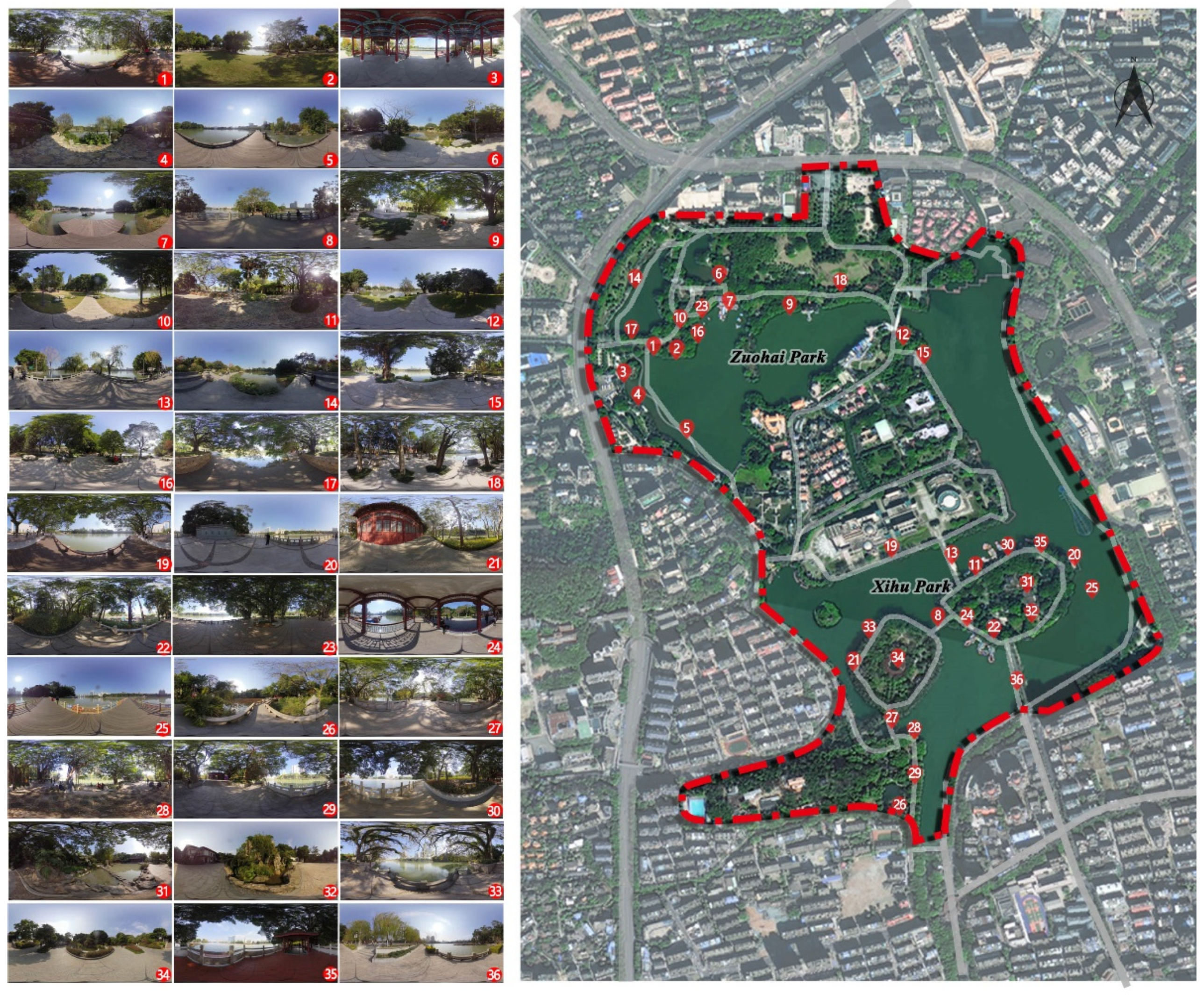

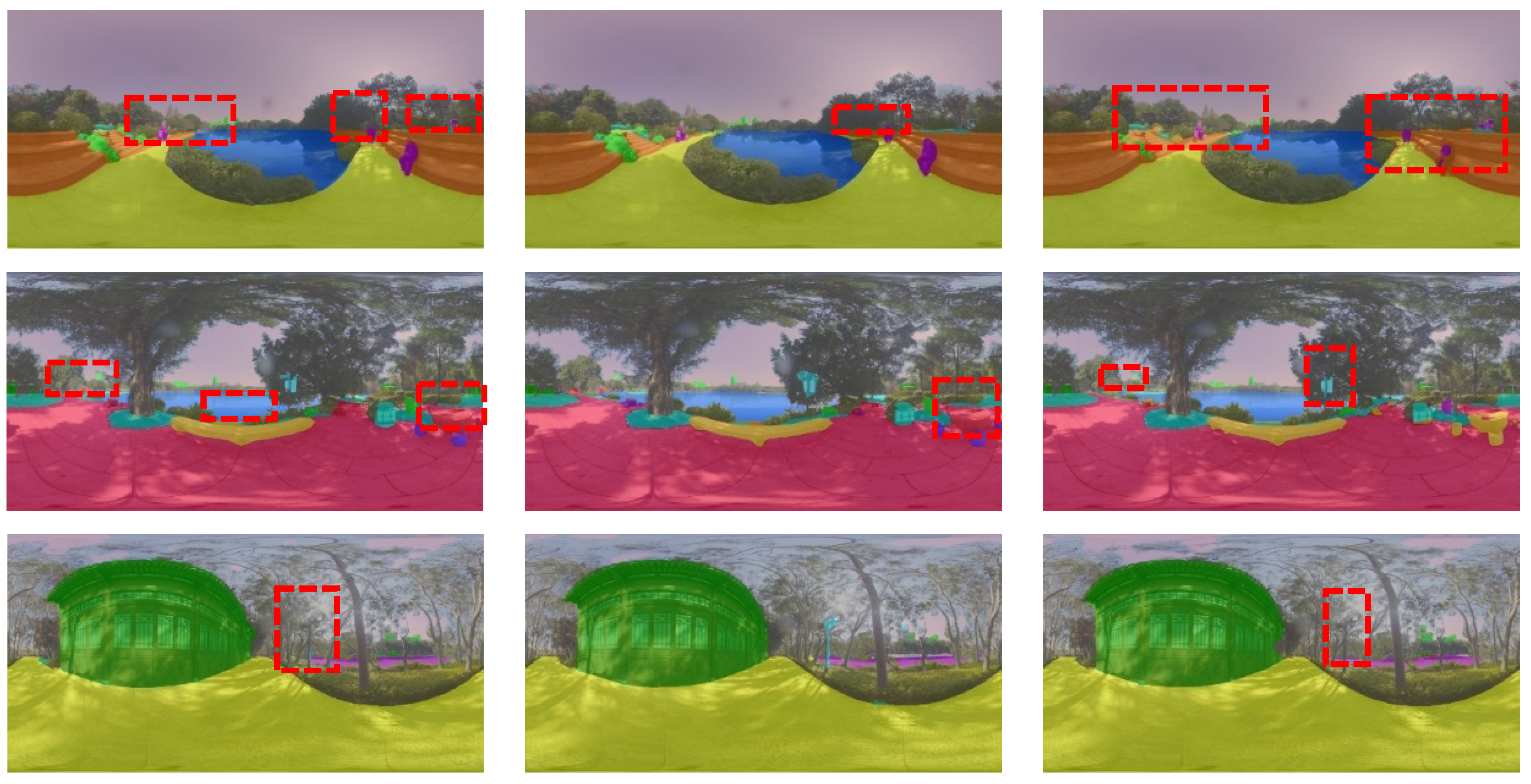

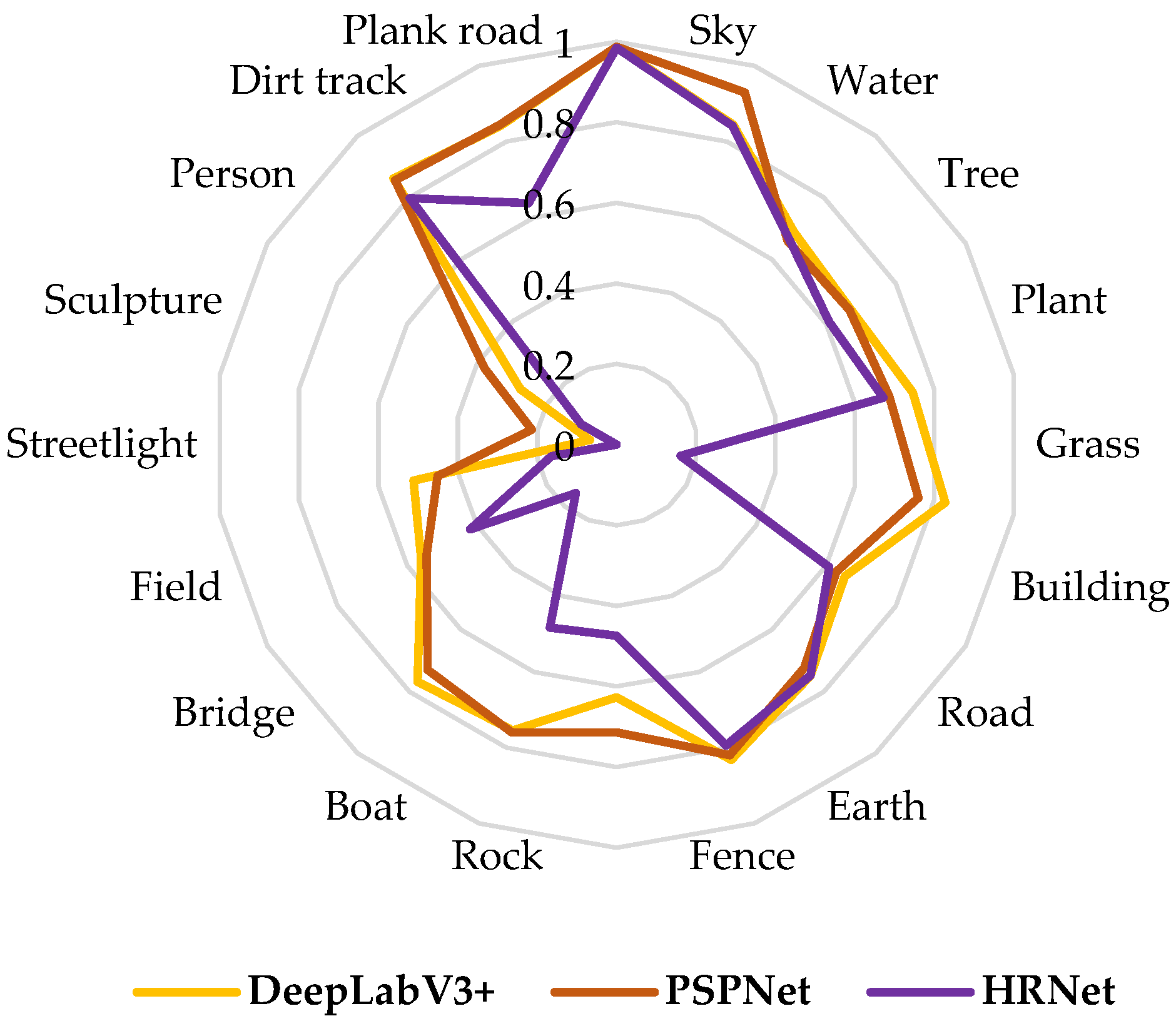


| Dimensions | Item | Score |
|---|---|---|
| (F1) Emotional dimensions | V1, Grouchy–Good natured | 1, 2, 3, 4, 5, 6, 7 |
| V2, Anxious–Relaxed | 1, 2, 3, 4, 5, 6, 7 | |
| (F2) Cognitive dimensions | V3, I am interested in the presented scene | 1, 2, 3, 4, 5, 6, 7 |
| V4, I feel attentive to the presented scene | 1, 2, 3, 4, 5, 6, 7 | |
| (F3) Physiological dimensions | V5, My breathing is becoming faster | 1, 2, 3, 4, 5, 6, 7 |
| V6, My hands are sweating | 1, 2, 3, 4, 5, 6, 7 | |
| (F4) Behavioral dimensions | V7, I would like to visit here more often | 1, 2, 3, 4, 5, 6, 7 |
| V8, I would like to stay here longer | 1, 2, 3, 4, 5, 6, 7 |
| Name of Model | Model Network Architecture |
|---|---|
| DeepLabV3+ | 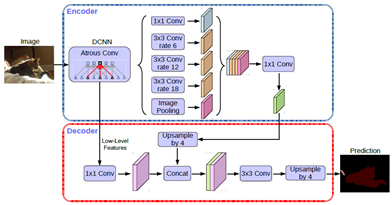 |
| PSPNet |  |
| HRNet | 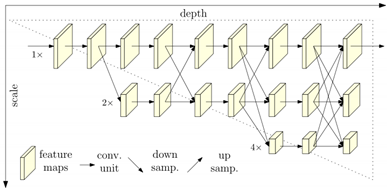 |
| PA | MIoU | Schematic Diagram 1 | Schematic Diagram 2 | |
|---|---|---|---|---|
| PSPNet-trained by ADE20k dataset | 0.8039 | 0.4189 | 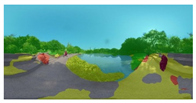 |  |
| PSPNet-trained by the dataset in this paper | 0.8783 | 0.6865 |  |  |
| Emotional Dimensions (E) | Cognitive Dimensions (C) | Physiological Dimensions (P) | Behavioral Dimensions (B) | |||||
|---|---|---|---|---|---|---|---|---|
| E1 | E2 | C1 | C2 | P1 | P2 | B1 | B2 | |
| Mean score of each subconstruct | 5.27 | 5.38 | 5.16 | 4.78 | 4.73 | 5.05 | 4.92 | 5.08 |
| Mean score of each construct | 5.32 | 4.97 | 4.89 | 5 | ||||
| Emotional Dimensions (E) | Cognitive Dimensions (C) | Physiological Dimensions (P) | Behavioral Dimensions (B) | |||||
|---|---|---|---|---|---|---|---|---|
| E1 | E2 | C1 | C2 | P1 | P2 | B1 | B2 | |
| Mean score of each subconstruct | 4.11 | 4.21 | 3.57 | 3.62 | 4.32 | 4.65 | 3.35 | 3.24 |
| Mean score of each construct | 4.16 | 3.59 | 4.49 | 3.30 | ||||
| Model | B | Std. Error | Standardized Coefficients | t | Sig. | |
|---|---|---|---|---|---|---|
| F1 (R = 0.795 a, R2 = 0.632, Adjusted R2 = 0.570; F = 10.296, Sig. = 0.000 b) | (constant) | 4.855 | 0.218 | 22.272 | 0.000 | |
| K3 | 0.420 | 0.183 | 0.302 | 2.300 | 0.029 | |
| Z3 | 0.158 | 0.065 | 0.282 | 2.412 | 0.022 | |
| Z5 | −0.077 | 0.022 | −0.463 | −3.418 | 0.002 | |
| J2 | −0.013 | 0.005 | −0.367 | −2.851 | 0.008 | |
| S1 | −0.653 | 0.111 | −0.690 | −5.901 | 0.000 | |
| F2 (R = 0.739 a, R2 = 0.546, Adjusted R2 = 0.452; F = 5.808, Sig. = 0.000 b) | (constant) | 5.991 | 0.552 | 10.852 | 0.000 | |
| K2 | −0.462 | 0.176 | −0.398 | −2.622 | 0.014 | |
| Z1 | −0.013 | 0.004 | −0.614 | −3.163 | 0.004 | |
| Z3 | 0.234 | 0.092 | 0.348 | 2.545 | 0.017 | |
| Z5 | −0.075 | 0.027 | −0.379 | −2.743 | 0.010 | |
| J2 | −0.032 | 0.008 | −0.748 | −4.160 | 0.000 | |
| S1 | −0.558 | 0.148 | −0.490 | −3.768 | 0.001 | |
| F3 (R = 0.783 a, R2 = 0.614, Adjusted R2 = 0.480; F = 4.591, Sig. = 0.001 b) | (constant) | 5.839 | 0.438 | 13.321 | 0.000 | |
| K2 | −0.291 | 0.113 | −0.521 | −2.575 | 0.016 | |
| K3 | 0.331 | 0.132 | 0.410 | 2.498 | 0.019 | |
| Z1 | −0.012 | 0.004 | −1.193 | −3.122 | 0.004 | |
| Z2 | −0.033 | 0.010 | −0.773 | −3.305 | 0.003 | |
| Z3 | 0.217 | 0.054 | 0.668 | 4.050 | 0.000 | |
| Z6 | −0.114 | 0.053 | −0.293 | −2.138 | 0.042 | |
| J1 | −0.015 | 0.004 | −0.936 | −3.675 | 0.001 | |
| J2 | −0.015 | 0.006 | −0.706 | −2.597 | 0.015 | |
| S1 | −0.172 | 0.078 | −0.314 | −2.214 | 0.036 | |
| F4 (R = 0.721 a, R2 = 0.520, Adjusted R2 = 0.421; F = 5.240, Sig. = 0.001 b) | (constant) | 5.776 | 0.684 | 8.448 | 0.000 | |
| K2 | −0.551 | 0.218 | −0.394 | −2.525 | 0.017 | |
| Z1 | −0.012 | 0.005 | −0.454 | −2.275 | 0.030 | |
| Z3 | 0.320 | 0.114 | 0.393 | 2.802 | 0.009 | |
| Z5 | −0.107 | 0.034 | −0.444 | −3.130 | 0.004 | |
| J2 | −0.032 | 0.010 | −0.611 | −3.307 | 0.003 | |
| S1 | −0.583 | 0.183 | −0.426 | −3.183 | 0.003 |
Disclaimer/Publisher’s Note: The statements, opinions and data contained in all publications are solely those of the individual author(s) and contributor(s) and not of MDPI and/or the editor(s). MDPI and/or the editor(s) disclaim responsibility for any injury to people or property resulting from any ideas, methods, instructions or products referred to in the content. |
© 2023 by the authors. Licensee MDPI, Basel, Switzerland. This article is an open access article distributed under the terms and conditions of the Creative Commons Attribution (CC BY) license (https://creativecommons.org/licenses/by/4.0/).
Share and Cite
Li, J.; Huang, Z.; Zheng, D.; Zhao, Y.; Huang, P.; Huang, S.; Fang, W.; Fu, W.; Zhu, Z. Effect of Landscape Elements on Public Psychology in Urban Park Waterfront Green Space: A Quantitative Study by Semantic Segmentation. Forests 2023, 14, 244. https://doi.org/10.3390/f14020244
Li J, Huang Z, Zheng D, Zhao Y, Huang P, Huang S, Fang W, Fu W, Zhu Z. Effect of Landscape Elements on Public Psychology in Urban Park Waterfront Green Space: A Quantitative Study by Semantic Segmentation. Forests. 2023; 14(2):244. https://doi.org/10.3390/f14020244
Chicago/Turabian StyleLi, Junyi, Ziluo Huang, Dulai Zheng, Yujie Zhao, Peilin Huang, Shanjun Huang, Wenqiang Fang, Weicong Fu, and Zhipeng Zhu. 2023. "Effect of Landscape Elements on Public Psychology in Urban Park Waterfront Green Space: A Quantitative Study by Semantic Segmentation" Forests 14, no. 2: 244. https://doi.org/10.3390/f14020244
APA StyleLi, J., Huang, Z., Zheng, D., Zhao, Y., Huang, P., Huang, S., Fang, W., Fu, W., & Zhu, Z. (2023). Effect of Landscape Elements on Public Psychology in Urban Park Waterfront Green Space: A Quantitative Study by Semantic Segmentation. Forests, 14(2), 244. https://doi.org/10.3390/f14020244







